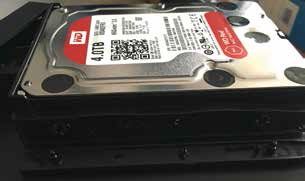articles/Storage/storage-backup-page6
Storage and Backup - Saving Your Bacon - part 6 of 1 2 3 4 5 6 7
by Mike McNamee Published 01/12/2015

What to Back Up - A Check list
Your hard drive may contain hundreds of thousands of files (the Imagemaker workstation has at least 815,500). Many of them should be backed up every day, others only occasionally, and still others - including temp files, the hibernation file (hiberfil.sys), and your browser cache - not at all. Here are examples: Your documents:
For a photographer this is the core requirement and governs the large size of storage that is required. You should back up your Raw files, in-progress album files (say PSDs), word processing files, spreadsheets, and similar documents every day. Any basic backup program can perform incremental backups, in which the program copies only the files that have changed since the most recent previous backup. (Good backup programs also perform versioning; that is, they keep several iterations of the same file on hand and enable you to choose which version to restore although you can save snapshots from Photoshop for the same effect.)
Your recent documents:
If your backup program can handle incremental backups, you don't have to worry about recent documents as separate entities. But if you work on these files on other people's computers, you may want to carry a copy of them on a flash drive or store a copy of them.
Application data:
Apps create and maintain data files such as e-mail messages, browser favourites, calendar entries, and contacts that require daily backing up. Most programs store them in a hidden folder inside your user folder. By way of example my Skype files are found at C:\Users\Mike\AppData\Roaming\Skype\My Skype Received Files. Here you will find stuff that we pass back and forth between Rhyl HQ and Editor Towers. The application data category also includes such things as Photoshop Actions, Brushes, Swatch sets, templates and proformas - anything you have spent time making!
Surveillance Camera Media:
If you have surveillance cameras as part of your business security package then you need to be able to access those files after an event such as damage or break-in. Heirlooms: Files that you want to keep forever - family photos, special anniversary cards, invitations and so on - need backing up and extra protection.
Your system:
You can always reinstall Windows and your apps, if you have the original discs or can download the programs. But if Windows becomes unusable or your hard drive crashes, switching to a system backup (also called a disaster recovery backup) that you create a couple of times a year can get your machine up and running smoothly without much effort.
Please Note:
There is more than one page for this Article.
You are currently on page 6
- Storage and Backup - Saving Your Bacon page 1
- Storage and Backup - Saving Your Bacon page 2
- Storage and Backup - Saving Your Bacon page 3
- Storage and Backup - Saving Your Bacon page 4
- Storage and Backup - Saving Your Bacon page 5
- Storage and Backup - Saving Your Bacon page 6
- Storage and Backup - Saving Your Bacon page 7
1st Published 01/12/2015
last update 09/12/2022 14:59:21
More Storage Articles
There are 28 days to get ready for The Society of Photographers Convention and Trade Show at The Novotel London West, Hammersmith ...
which starts on Wednesday 14th January 2026





